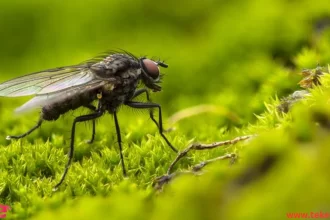The Arctic Hare is a type of rabbit that is highly adapted to mountainous and polar habitats, and is characterized by its thick fur coat.
Let’s learn more about it from teketrek.
Arctic hares facts
The Arctic Hare is known for digging a burrow in the ground under the snow to sleep and stay warm.
Its scientific name is Lepus arcticus, it belongs to the order Lagomorpha, family Leporidae.
Often, ten hares up to sixty hares gather in groups during nursing, and in the northern parts of their range, they are known to gather in groups of up to three hundred hares.
The Arctic hare belongs to the same family as wild rabbits, and it looks very similar to them, but the main difference is that wild rabbits are larger and have shorter ears.
The face and feet of the Arctic hare are the first parts to molt, followed by the ears, shoulders, legs, and rear.
Its white fur provides effective camouflage against predators during the winter..
The thick white fur helps the Arctic hare withstand low temperatures and easily blend in with local plants and rocks.
In severe cold, wild hares hide behind rocks or in burrows they dig, living in relatively small areas in search of food.
The Arctic hare’s body is composed of 20% fat, with a thick layer of fur, and it can dig holes in the ground.

The Arctic Hare specification
Size: The Arctic Hare is one of the largest wild rabbits.
The Feet: The Arctic hare has large feet with heavily padded front and back claws, which it uses to dig through stacked snow.
The Weight: It weighs between 3 to 5 kg.
The length: measures from 480 to 600 mm.
The ear: Its ears have black tips.
The Fur: The Arctic hare has thick fur, with gray color on its chest and belly.
Incisors, teeth: It also has longer front incisors and teeth, which are straighter, used for pulling plants from rock crevices.
The Tail, Legs: The Arctic hare has a thin tail and long, strong hind legs that allow it to jump quickly through deep snow.
The color: The color of the Arctic hare’s coat changes seasonally. In winter, its coat appears long, thick, soft, and white. In summer, its coat changes to grayish-brown or grayish-blue.
Animals unaffected by cold: secrets of organisms’ adaptation to freezing environments
The Arctic Hare specification
The Arctic hare is found throughout the northern regions of Greenland and Canada, including areas such as Ellesmere Island, Newfoundland, and Labrador.
The Arctic hare inhabits mountain tundra areas, rocky plateaus, and treeless coastal regions.
It is well adapted to extremely cold climates and icy rains.
What do Arctic hares eat?
Arctic hares are animals herbivorous with a plant-based diet.
Its long claws help them find food.
Arctic hares consume woody species in their diet, such as saxifrage, blueberries, and willow dwarf. Willow dwarf constitutes 95% of their diet.
In the summer, their diet includes other plant species such as lichens, algae, flowers, leaves, as well as branches and roots.
They sometimes eat meat like fish and small animals, especially those caught in traps.
Reproduction stages of Arctic hares
Arctic hares find a mate for each breeding season and mating occurs between summer and spring.
After giving birth, the male leaves to find another partner.
It reaches sexual maturity at 315 days of age.
The male Arctic hare courts the female through physical contact, often licking and scratching.
The gestation period for the female is about 50 days, and she usually gives birth to one offspring annually.
Female Arctic hares typically give birth to 2 to 8 leverets.
They grow rapidly to adulthood within several months and are able to mate in the following year.

FAQs about Arctic hare
What are the important uses of Arctic hare fur?
Arctic hares were considered a vital resource for indigenous populations and Native Americans in providing food and fur used in making shoes and clothing.
What is the lifespan of Arctic hares?
The average lifespan of an Arctic hare is around 5 years if not killed by predators or due to non-natural causes.
What threats do Arctic hares face?
Arctic hares face several threats including habitat loss in the southern part of their range, as well as unregulated hunting in some areas.
The Arctic fox is one of the most important predators that preys on Arctic hares.
What is special about Arctic hare?
Hares are slightly larger than rabbits, with taller hind legs and longer ears.
How many babies do arctic hares have?
It has up to 8 babies, known as leverets, with an average litter size of 5.4. The leverets remain within their mother’s home range until they are capable of surviving independently. Young Arctic hares reach nearly full size by late July, just a few weeks after birth, and they typically begin breeding at around one year of age.
How many Arctic hares are left in the world?
There are no statistics on their number.
In conclusion, the Arctic Hare is specie of hares live individually and isolated.
References:
Wikipedia





